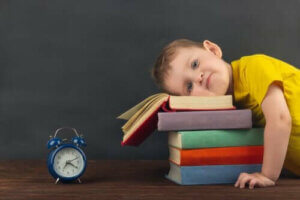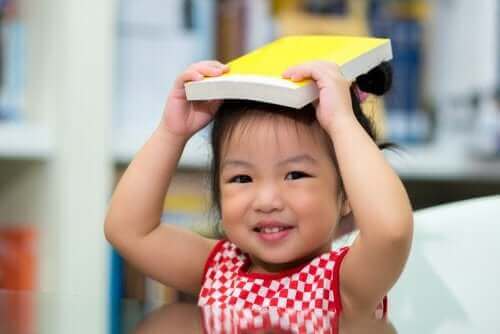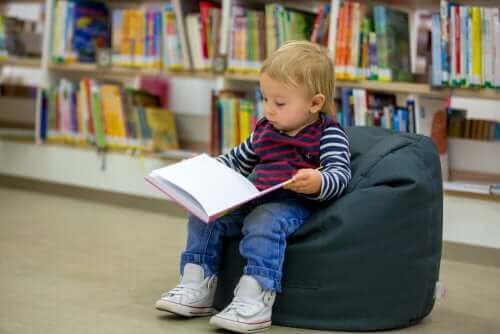Baby Library: A Special Space Just for Babies

Although it may seem unimaginable, many years ago, the number of libraries that existed was very small and, therefore, the space for children was even more limited. And, of course, the concept of a baby library was altogether inexistent.
However, in this day and age, it’s common for people to go to the library, either to enjoy a good book or to look for information. This fact has caused the number of libraries to grow. Nevertheless, there was a boom in children’s literature in the late 1970s, and this led to an increasing number of libraries devoted to children in the 1980s.
As a general rule, these children’s sections of the libraries were designed for children ages three and up. But what about babies and children that are under age three? Shouldn’t they also be able to enjoy books in their own way?
Until a few years ago, the answer was, in the vast majority of libraries, no. However, little by little, more and more libraries are including a baby library. Today we’ll tell you a little more about this fantastic space for babies.

What is a baby library?
The opening of this space within the libraries made a great impact on some people and regular library users. The question they all asked themselves was the same: How could babies have a place in a space designed for reading?
Before 1987, when it was first discussed at the 5th European Reading Conference held in Salamanca at the Germán Sánchez Ruipérez Foundation, the term “baby library” didn’t even exist. From that moment on, the term took on the following meaning:
“A special service for young children (ages 0 to 6) that includes a space and a collection of books chosen to satisfy the needs of the youngest readers and their parents, as well as the loaning of these books, periodic talks on their use, and on the stories, advice, and constant attention from the library professionals towards the users.”
The importance of the baby library for little ones
We’re all aware that baby library users still don’t know how to read, but what does that matter when there are hundreds of books with shapes, colors and textures just for them? The implantation of a section for babies within libraries has several essential objectives for child development.
Growing up among books
If we get babies used to establishing a bond with books from an early age, this will continue during their growth in a much simpler way than if we try to do it when they’re older.
Stimulation and development
One of the most important objectives that baby clubs have is to promote and stimulate development in babies. Books that include textures, colors and shapes attract their attention and help in their learning.
Greater emotional bonding
These spaces encourage infants and toddlers to discover and explore books on their own, in an autonomous way. However, they also reinforce the bond between children and their parents as they share stories and time together.

What should a baby library look like?
Above all, a baby library should be a safe space. By this we mean that it shouldn’t contain furniture that can tip over or that has sharp corners, as this can be dangerous for little ones.
In addition, a baby library should be a pleasant and welcoming space where babies and toddlers can feel comfortable. It’s a good idea for there to be large mats or pillows on the floor so children can sit together and interact with one another.
Also, all the books should be within their reach so that they can choose them themselves if they attract their attention.
What kind of books are included in this section?
As we’ve implied before, in this section, you won’t find books with a lot of text. However, it’s true that, depending on the child’s age, they’ll be more or less available. The star books in this section almost all have a similar format:
- Small size
- Come in cardboard format, special plastic for the bathtub, or cloth
- Large illustrations
- Bright colors
However, books aren’t the only things that this section should contain. Baby libraries should also have special storytellers for babies, as well as other types of age-appropriate activities.
Although it may seem unimaginable, many years ago, the number of libraries that existed was very small and, therefore, the space for children was even more limited. And, of course, the concept of a baby library was altogether inexistent.
However, in this day and age, it’s common for people to go to the library, either to enjoy a good book or to look for information. This fact has caused the number of libraries to grow. Nevertheless, there was a boom in children’s literature in the late 1970s, and this led to an increasing number of libraries devoted to children in the 1980s.
As a general rule, these children’s sections of the libraries were designed for children ages three and up. But what about babies and children that are under age three? Shouldn’t they also be able to enjoy books in their own way?
Until a few years ago, the answer was, in the vast majority of libraries, no. However, little by little, more and more libraries are including a baby library. Today we’ll tell you a little more about this fantastic space for babies.

What is a baby library?
The opening of this space within the libraries made a great impact on some people and regular library users. The question they all asked themselves was the same: How could babies have a place in a space designed for reading?
Before 1987, when it was first discussed at the 5th European Reading Conference held in Salamanca at the Germán Sánchez Ruipérez Foundation, the term “baby library” didn’t even exist. From that moment on, the term took on the following meaning:
“A special service for young children (ages 0 to 6) that includes a space and a collection of books chosen to satisfy the needs of the youngest readers and their parents, as well as the loaning of these books, periodic talks on their use, and on the stories, advice, and constant attention from the library professionals towards the users.”
The importance of the baby library for little ones
We’re all aware that baby library users still don’t know how to read, but what does that matter when there are hundreds of books with shapes, colors and textures just for them? The implantation of a section for babies within libraries has several essential objectives for child development.
Growing up among books
If we get babies used to establishing a bond with books from an early age, this will continue during their growth in a much simpler way than if we try to do it when they’re older.
Stimulation and development
One of the most important objectives that baby clubs have is to promote and stimulate development in babies. Books that include textures, colors and shapes attract their attention and help in their learning.
Greater emotional bonding
These spaces encourage infants and toddlers to discover and explore books on their own, in an autonomous way. However, they also reinforce the bond between children and their parents as they share stories and time together.

What should a baby library look like?
Above all, a baby library should be a safe space. By this we mean that it shouldn’t contain furniture that can tip over or that has sharp corners, as this can be dangerous for little ones.
In addition, a baby library should be a pleasant and welcoming space where babies and toddlers can feel comfortable. It’s a good idea for there to be large mats or pillows on the floor so children can sit together and interact with one another.
Also, all the books should be within their reach so that they can choose them themselves if they attract their attention.
What kind of books are included in this section?
As we’ve implied before, in this section, you won’t find books with a lot of text. However, it’s true that, depending on the child’s age, they’ll be more or less available. The star books in this section almost all have a similar format:
- Small size
- Come in cardboard format, special plastic for the bathtub, or cloth
- Large illustrations
- Bright colors
However, books aren’t the only things that this section should contain. Baby libraries should also have special storytellers for babies, as well as other types of age-appropriate activities.
All cited sources were thoroughly reviewed by our team to ensure their quality, reliability, currency, and validity. The bibliography of this article was considered reliable and of academic or scientific accuracy.
- Corchete, T. Una propuesta para acercar los libros a los bebés. Disponible en: https://gredos.usal.es/handle/10366/118628
This text is provided for informational purposes only and does not replace consultation with a professional. If in doubt, consult your specialist.








